|
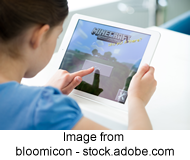 Student engagement has become a serious challenge for
teachers in online environments. One challenge in teaching any syllabus is
where to depart from it and address the whole student—that is, identify
activities that are intrinsically interesting, motivate students to want to
stay on task, and apply critical thinking and problem-solving skills while
practicing listening, speaking, reading, and writing communicatively, and link
that back to a curriculum. The challenge becomes more acute when classes are
being conducted virtually.
Student engagement has become a serious challenge for
teachers in online environments. One challenge in teaching any syllabus is
where to depart from it and address the whole student—that is, identify
activities that are intrinsically interesting, motivate students to want to
stay on task, and apply critical thinking and problem-solving skills while
practicing listening, speaking, reading, and writing communicatively, and link
that back to a curriculum. The challenge becomes more acute when classes are
being conducted virtually.
Teachers in
such contexts are finding ways to connect synchronously with one another to
share activities that will address this conundrum. To counter “Zoom fatigue,”
teachers might introduce an element of virtual worlds for variety in how they
teach in synchronous online environments. I have been working for the past 7
years with a group of teachers who have been learning about and developing
their skills in Minecraft as one approach to the problem of finding compelling
virtual spaces for materials and language development. Our focus has been on
bringing each other up to speed with the game and in so doing extrapolate to
how we can use it with students.
We started
with exposure to how other teachers were building spaces in Minecraft for
student language development, and seeing that this would be worthwhile for our
students, we had to become familiar with the game itself in order to adapt it
to our purposes.
Minecraft is
couched in a participatory culture that elicits communication among
participants. Success in developing language skills through Minecraft derives
from incentives to unlock its depth and opportunities for creativity and
sharing insights with others in the learning community. There are many
communities of learners and teachers who utilize Minecraft as a substrate to
their learning goals (Smolčec, Smolčec, & Stevens, 2014).
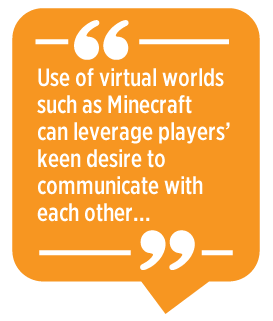 Our
Minecraft professional community came together through association with the
TESOL Computer-Assisted Language Learning Interest Section project Electronic
Village Online (EVO). EVO has just celebrated its 20th anniversary as a viable
and productive community of practice (CoP) where teachers learn from one
another in online workshops covering a range of topics for 5 weeks preceding
each annual TESOL convention. Teachers volunteer to organize sessions where
anyone can participate for free, whether they are TESOL members or not. The EVO Minecraft MOOC sessions started in
2015 and have just completed their 7th iteration as an annual EVO
session. Our
Minecraft professional community came together through association with the
TESOL Computer-Assisted Language Learning Interest Section project Electronic
Village Online (EVO). EVO has just celebrated its 20th anniversary as a viable
and productive community of practice (CoP) where teachers learn from one
another in online workshops covering a range of topics for 5 weeks preceding
each annual TESOL convention. Teachers volunteer to organize sessions where
anyone can participate for free, whether they are TESOL members or not. The EVO Minecraft MOOC sessions started in
2015 and have just completed their 7th iteration as an annual EVO
session.
Why Use Minecraft for
Language Learning?
Minecraft is
a deeply structured, open-ended, and creative game. Developed in 2009, it was
soon discovered by educators who found that the problem-solving and critical
thinking features inherent in the game appealed to students and teachers alike
and might be beneficial if ported into their learning contexts. Furthermore,
the participatory culture surrounding the game was ripe with opportunities for
creativity and developing skills in multimedia communication, frequently in
second languages.
Kuhn and
Stevens (2017) show how use of virtual worlds such as Minecraft can leverage
players’ keen desire to communicate with each other what they are learning
about their domain, their interest in Minecraft, and how this can further their
language learning and teaching objectives. Whether the participants are
students or teachers, they are learning new ways of self-directed and
autonomous learning through playing a game that can be used in a wide range of
pedagogical contexts.
Our CoP has
identified many affordances of Minecraft for language learning. For example,
Minecraft is
-
Fun:
Minecraft is inherently gamified to attract play, increasing time-on-task for
language learning.
-
Creative:
Unlike games that limit what players can do in the game, each player in
Minecraft is by default a builder, free to structure their world at
will.
-
Game
based: Minecraft can be modified by teachers to create
customized learning environments directed at promoting concepts in the
curriculum.
-
Community
based: Minecraft has an extensive range of networks and
resources in almost any medium, easily discoverable using Google or YouTube
searches online.
-
Communicative:
Minecraft encourages communication, including student narratives, multimedia
productions, conversations with teachers and peers, and eTwinning (learning in
partnership with students in other settings, often for the purpose of
developing skills in each other’s languages).
-
Inquiry
based: Minecraft encourages research using Google and YouTube, acting on
such reading and listening, and communicating discoveries to others.
Learning to Use
Minecraft With Students
The
community aspect is critical for giving participants purpose for being in-game,
for learning its intricacies, and for allowing a sense of success through rapid
improvement in one’s target skills as practiced under the apprenticeship of
others. Minecraft is not a game that can be fully appreciated while playing in
isolation. However, educators needing to preserve kid-safe environments rarely
encourage the participation of other adults. So, we brought the CoP approach to
bear on a solution when we invited teaching peers facing this common hurdle to
join us in EVO Minecraft MOOC.
As our CoP
grew, we found we had a wide range of expertise. Many of our participants were
already knowledgeable in the game and willing to help scaffold others. There
were even people there who would set up a server for us and keep it running for
the past 7 years. By now, EVO Minecraft MOOC has become a viable CoP couched in
a complex ecosystem based in numerous social networks, including Facebook,
Discord for voice and discussion, and the game itself (Stevens, 2019).
Examples of Use With
Language Learners
Choosing an Edition
Compatible With Your Platform
Before using
Minecraft, teachers need to choose an edition compatible with the platform students
will be using. The classic
Java edition, which costs less than US$30, is the most flexible
option because it provides unlimited play and download of software on a
theoretically unlimited number of devices. Schools can purchase the Minecraft
Education Edition for an annual license of US$5 per workstation,
allowing multiplayer through the school’s network. There are also hosted
solutions, for example Minecraft
Realms, where for US$8 a month you can host up to 10 players at a
time in either Java (for PC, Mac, or Linux) or Bedrock (not compatible with
Java).
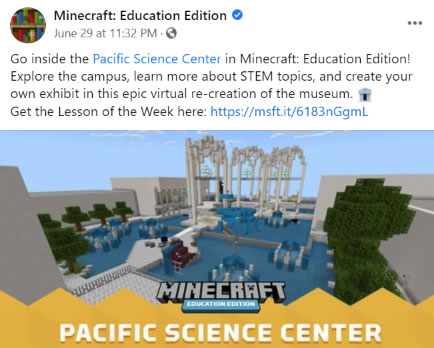
Example of
an educational resource pack suitable for STEM; hence CLIL; hence language
learning. (Posted June 29, 2021 at www.facebook.com/playcraftlearn.
Available on the Minecraft
Education Edition website.)
Directing the
Process
Once your
students are in Minecraft, there is the question of who directs the process.
The students can show the teacher what they know as a focus of language
communication. A presenter at an ISTE Conference in Philadelphia said she
observed her students playing Minecraft during breaks between classes, and they
suggested they play Minecraft during class time. She would agree only if it
supported her curriculum, so the students worked with her to propose and
document activities that she could use to justify to her administrators how
that could be done, which launched a unique learning experience for both
students and teacher.
Exploiting
Opportunities for Learning
Teachers
learning from students is a powerful motivator in support of authentic
opportunities for meaningful communication, but the more teachers learn about
Minecraft, the more they are able to set up environments where learning can be
directed. For example, they can exploit the presence of hidden temples that occur
in game, or construct their own builds to facilitate lessons on civilizations
and archaeology. Moderators of EVO Minecraft MOOC have also shown us resource
packs that relate to timely topics, such as a Mars lander introduced to
coincide with the 2020
NASA Mars mission.
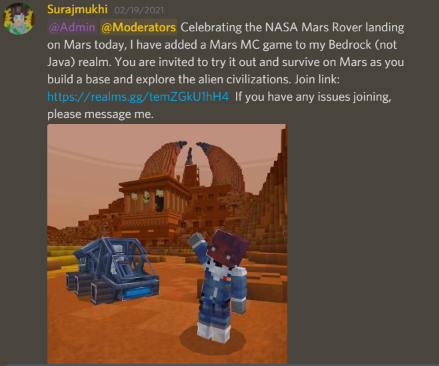
Post by
Surajmukhi to the EVO Minecraft Discord channel in the Partyplanners-Text-Chat
discussion.
The Virginia
Society of Technology in Education (VSTE) is another robust CoP where teachers
meet monthly to show each other how to tweak the game, often having students
demonstrate how they use the game to meet learning objectives. Students have
created phenomenal builds, such as mockups of NASA space rockets complete with
finely detailed interiors, as well as a haunting mockup of a WWII concentration
camp.
The two
following screen shots were made on a tour hosted by VSTE at one of their
regularly scheduled Minecraft Mondays, where they often meet with student East
Coast Miners to showcase their projects. (Find these and other projects by East
Coast Miners described in greater detail at learning2gether.net.)
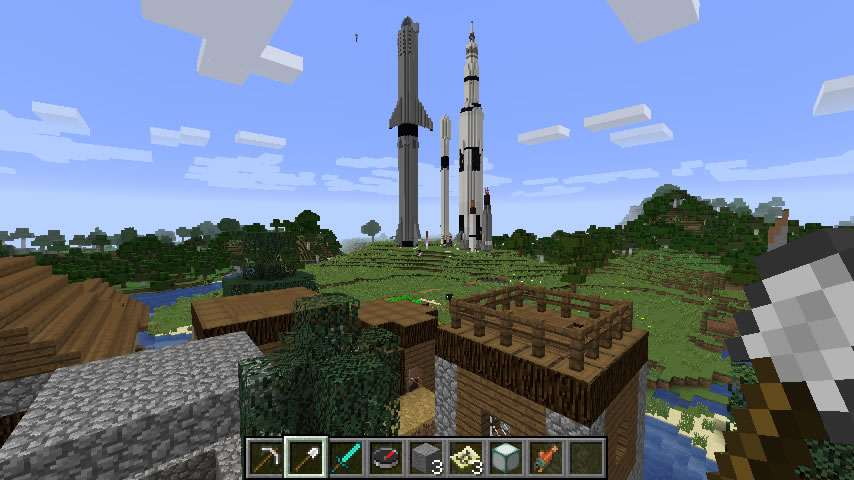
This build
shows the several rockets replicated in fine-scaled interior and exterior
detail by one of the students.
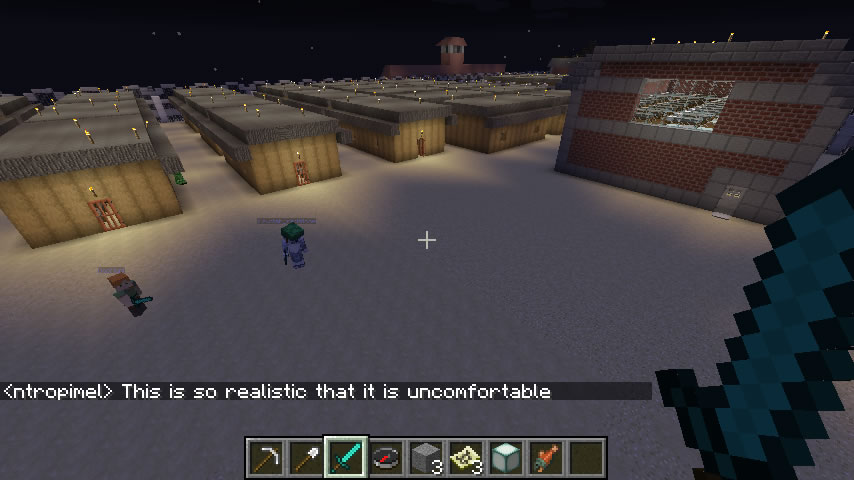
This build
overviews an interactive reproduction of a Nazi concentration camp rendered by
a student to create a perspective of how one might have experienced life there.
The
potential for communicating processes derives from the complexity of objects
that occur in game; for example, the ocean biomes present challenges for
players who can use in-game chemistry to create potions allowing them to
breathe there. There is no end of videos and wiki pages students can research
to learn more, and unlocking one process opens other discoveries that parallel
real-life lessons on ecology and sustainability. VSTE students maintain turtle
farms, and even the simple act of learning how to craft a fishing pole can open
significant possibilities. One VSTE project had students record fish catches
and enter the data into a database linked through Discord to reveal
patterns—and just catching fish increases experience points, which increase
power to create potions. Fish can also be used to tame cats, which will bring
their owners useful and hard to find objects overnight (and taming dogs affords
a level of protection as they will aggressively attack monsters to protect
their owners).
Problem-solving in Minecraft includes
cartography and orienteering. Maps can be obtained from villagers and followed
to surprising locations, or maps can be found on shipwrecks strewn about
Minecraft. It’s a difficult puzzle to extract them from underwater chests, but
once found they point the way to treasure. Following a map requires
trigonometric and orientation skills and yields fun opportunities for
meaningful collaboration.
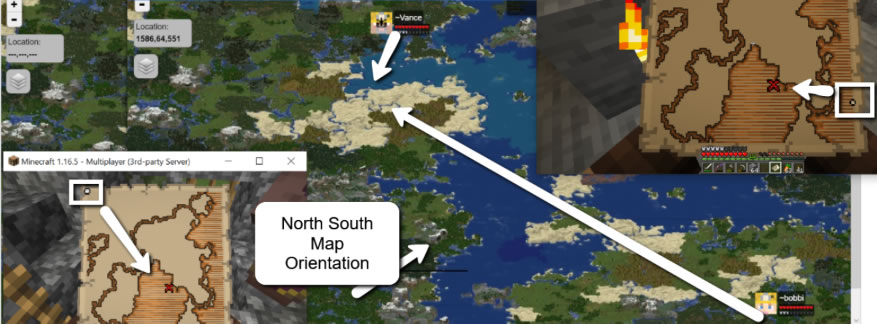
Screenshot
showing triangulation on map location to find buried treasure.
Another
important level of depth in Minecraft is in learning about redstone (a useful
building material in the game, found deep underground) and how to use it to
power your builds and create logic gates that make things happen
algorithmically. VSTE provides workshops to explain the intricacies, and in EVO
Minecraft MOOC, we have learned this skill from our young participants, who
relish explaining it to us, as in this example on
YouTube.
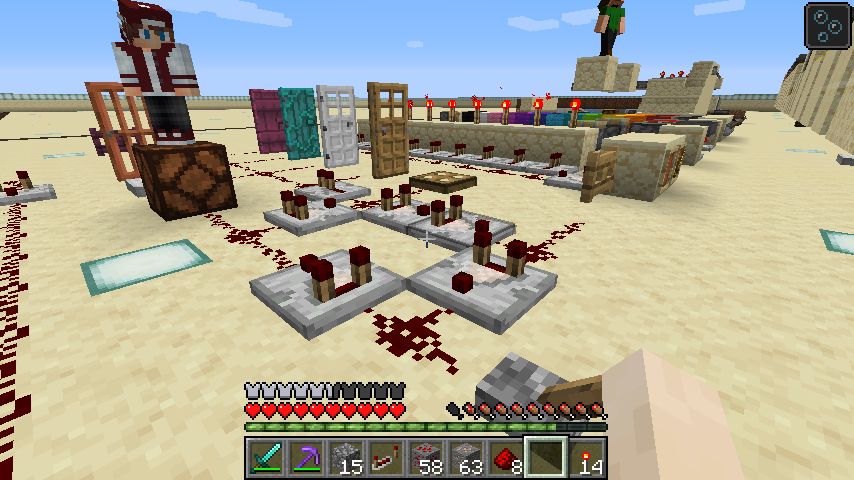
Screenshot
of a VSTE Minecraft Monday workshop on redstone basics.
Conclusion
Our most
recent need to move into online environments—teachers and students in
classrooms and educators holding webinars and conferences—has changed our
thinking, making us more amenable to adapting what is positive about those
contexts into our inevitable reconception of education. One such change is a
natural move of professional development into CoPs, which makes more likely a
consideration of more engaging spaces for learning online than simply Zoom
re-creations of traditional classroom practices. Virtual worlds are an
increasingly frequent topic of webinars in CoPs, as are gamification and
game-based learning. These features should figure more prominently in future development
as we create materials and interfaces for meeting our language learners
online.
References
Kuhn, J.,
& Stevens, V. (2017). Participatory culture as professional
development: Preparing teachers to use Minecraft in the classroom.TESOL Journal 8(4), 753–767. https://doi.org/10.1002/tesj.359
Smolčec, M.,
Smolčec, F., & Stevens, V. (2014). Using Minecraft for learning
English. TESL-EJ, 18(2), 1–15. http://www.tesl-ej.org/pdf/ej70/int.pdf.
Stevens, V.
(2019). Gamifying teacher professional development through Minecraft MOOC. In
D. Barr, E. Bañados, & A. Gimeno (Eds.), Proceedings of
WorldCALL 2018, Concepción, 13-16 November, 2018: CALLing all the CALLers
Worldwide (pp. 122–125). Universidad de Concepción. http://worldcall5.org/images/WorldCALL_2018_Proceedings_compressed.pdf
Vance
Stevens hosts the podcast
series Learning2gether,
which has more than 520 episodes. He founded the CoP Webheads
in Action in 2002 and has coordinated the TESOL
Computer-Assisted Language Learning (CALL) Interest Section Electronic Village
Online since 2003. He has been lead moderator of EVO Minecraft
MOOC since 2015. In 2019, he was awarded the
CALL Research Conference Lifetime Achievement Award for that
year. |